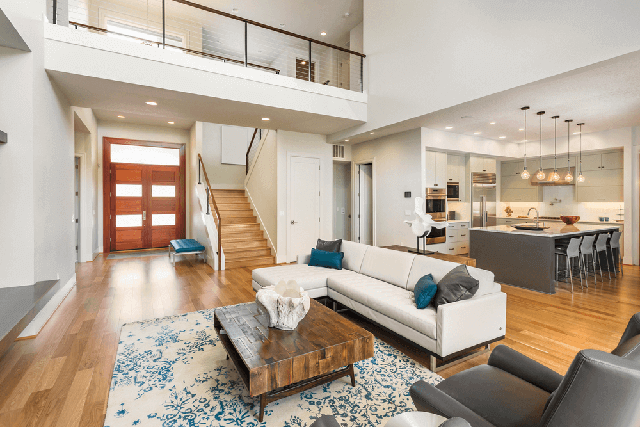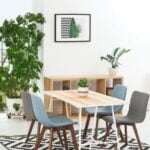Decorating a small area in a home can present unique challenges, but with the right strategies and tips, even the tiniest space can be transformed into a stylish and functional area. In this article, we’ll explore how to make the most of limited square footage, create the illusion of space using colors and patterns, maximize functionality with multi-functional furniture, and organize and declutter with smart storage solutions.
From enhancing ambiance with lighting and mirrors to adding personal touches and visual interest, we’ll cover everything you need to know about decorating a mini area in your home.
When it comes to decorating a mini area in a home, every inch counts. It’s important to assess the space carefully and make intentional choices to ensure that every element serves a purpose. With the right approach, even the smallest nook or cranny can become a cozy and inviting space that reflects your personal style.
In the following sections, we’ll delve into specific techniques for transforming a compact area into an aesthetically pleasing and practical part of your home. By the end of this article, you’ll have all the tools you need to elevate your mini space and make it both visually appealing and highly functional.
Assessing the Space
Measure and Plan
The first step in assessing a mini area is to accurately measure the space and take note of any architectural features, such as windows, doors, or alcoves. With these measurements in hand, you can then plan the layout of the area, considering factors such as traffic flow, functional zones, and furniture placement. This mindful approach to spatial planning will help you make the most of every inch and avoid cluttered or cramped arrangements.
Utilize Vertical Space
One effective way to maximize limited square footage is to utilize vertical space. Consider installing tall shelving units or wall-mounted storage solutions to free up floor space and keep belongings organized. Additionally, hanging curtains or artwork higher than eye level can draw the eye upward and create an illusion of height, making the area feel more spacious.
Consider Scale and Proportion
When selecting furniture for a mini area, it’s important to consider scale and proportion. Opt for sleek and appropriately sized pieces that won’t overpower the space. Additionally, incorporating furniture with legs can create a sense of openness by allowing visibility underneath, while also providing an airy feeling within the small area.
By carefully measuring the space, utilizing vertical storage solutions, and considering scale and proportion when choosing furniture, you can effectively assess a mini area in your home and make the most of limited square footage. These thoughtful considerations will contribute to creating a harmonious and well-designed small space that feels both functional and visually appealing.
Choosing the Right Colors and Patterns
When decorating a mini area in a home, choosing the right colors and patterns is crucial in creating the illusion of space. The use of color and patterns can significantly impact how large or small a room feels, making it an essential aspect to consider when working with limited square footage. Here are some tips on how to choose the right colors and patterns to maximize the visual space in a small area.
Light, Neutral Colors
Opting for light and neutral colors such as whites, creams, light grays, and pastels can make a small space feel more open and airy. These hues reflect light, making the room appear brighter and more spacious. Additionally, lighter colors create an illusion of depth, giving the impression of a larger area.
Vertical Stripes and Patterns
Using vertical stripes or patterns on walls or furnishings can draw the eye upward, making the ceiling appear higher and the room feel taller. This visual trickery creates an expansive feeling within a compact area, helping to combat any feelings of confinement.
Muted Monochromatic Schemes
Monochromatic color schemes with subtle variations in shades can also contribute to a sense of spaciousness in a mini area. By incorporating different tones of the same color family, you can create a cohesive and visually uncluttered look that promotes an open atmosphere.
By strategically incorporating light and neutral colors, vertical stripes or patterns, as well as muted monochromatic schemes into your mini area’s design scheme, you can effectively create the illusion of space. These techniques will help you transform even the smallest nook or cranny into a visually appealing and inviting space within your home.
Multi-Functional Furniture
When decorating a mini area in a home, one of the most important considerations is choosing the right furniture. In a small space, every piece of furniture needs to serve multiple functions in order to maximize functionality without sacrificing style. Here are some tips on how to choose and use multi-functional furniture to make the most of a small area:
- Convertible Sofa Beds: A sofa that can easily be converted into a bed is perfect for a mini area that doubles as a guest room. Look for options that are stylish and comfortable for seating, but also easy to transform into a bed when needed.
- Drop-Leaf Tables: When it comes to dining or working areas in a small space, consider using drop-leaf tables that can be expanded or collapsed depending on the need for more surface area. This allows for flexibility in using the space for different purposes.
- Storage Ottomans: In a mini living room or lounge area, storage ottomans are great multi-functional furniture pieces that provide both seating and hidden storage for extra blankets, pillows, or other items.
In addition to choosing the right multi-functional furniture pieces, it’s also important to consider how they can be arranged to create an efficient layout within the mini area. For example, utilizing wall-mounted shelves and floating desks can free up valuable floor space and make the room feel more open and spacious. By strategically placing multi-functional furniture and considering the flow of movement within the space, you can ensure that every square foot is used effectively.
Lastly, don’t underestimate the power of investing in custom-built or modular furniture designed specifically for small areas. While it may require a higher upfront cost, these pieces are tailored to fit perfectly within your mini space while offering multiple functions, making them well worth the investment in the long run. With careful consideration and creative thinking, it’s possible to furnish and decorate even the tiniest nooks and crannies of your home with style and functionality.
By incorporating multi-functional furniture into your decor plan, you can turn even the smallest spaces into versatile havens that meet all of your needs without feeling cramped or cluttered.
Storage Solutions
When it comes to decorating a mini area in a home, one of the biggest challenges is dealing with limited storage space. However, there are several creative and practical storage solutions that can help you keep your mini space organized and free from clutter.
One effective way to maximize storage in a small area is by utilizing multi-functional furniture pieces that offer built-in storage. For example, consider investing in a bed frame with drawers underneath or an ottoman that doubles as a storage compartment. These types of furniture not only provide extra space to keep items out of sight but also serve a dual purpose, making them ideal for mini areas.
Another great storage solution for mini spaces is vertical storage options. Shelves, wall-mounted organizers, and hanging racks can help free up floor space while providing ample room for storing items such as books, plants, or decorative accents. By taking advantage of vertical space, you can create the illusion of a larger area while keeping your belongings neatly organized.
In addition to furniture-based solutions, using decorative baskets, bins, and boxes can also help keep clutter at bay in a mini area. These storage containers not only provide practical organization for small items but also add visual interest to the space. When choosing storage containers, opt for pieces that complement the overall design and color scheme of your mini area to create a cohesive look.
| Storage Solution | Description |
|---|---|
| Multi-functional Furniture | Furniture pieces that offer built-in storage and serve dual purposes |
| Vertical Storage Options | Shelves, wall-mounted organizers, and hanging racks to free up floor space |
| Decorative Baskets/Boxes | Bins and boxes that provide practical organization and add visual interest |
Lighting and Mirrors
When it comes to decorating a mini area in a home, lighting and mirrors play a crucial role in enhancing the ambiance and brightness of the space. In a small area, it’s important to maximize natural light as much as possible. Consider adding sheer curtains or blinds that allow sunlight to filter through while still maintaining privacy. Additionally, strategically placing mirrors opposite windows can help bounce light around the room and make it feel more spacious.
In addition to natural light, consider incorporating layered lighting to create a well-lit and cozy atmosphere. Use a combination of overhead lighting, task lighting, and accent lighting to illuminate different areas of the mini space. Wall sconces or pendant lights can save valuable floor and surface space while adding personality to the room.
Mirrors can also be used to visually expand a small area. Whether it’s a statement mirror above a console table or a gallery wall of mirrors, these reflective surfaces can create the illusion of depth and openness. Consider choosing mirrors with decorative frames or interesting shapes to add style and visual interest.
For rooms with limited natural light, consider using lighter paint colors for walls and ceilings to reflect more light. Additionally, strategically placing lamps and other light sources throughout the space can help brighten up any dim corners. By paying attention to lighting and incorporating mirrors effectively, you can transform a mini area into a bright and inviting space within your home.
Personalizing the Space
When it comes to decorating a mini area in a home, personalization is key to adding character and style. Whether it’s a small corner of a room or a compact studio apartment, making the space feel like your own is essential. Here are some tips on how to personalize a mini area in your home:
- Add Personal Touches: Incorporate personal mementos such as family photos, souvenirs from travel, or sentimental items that bring joy and meaning to the space.
- Choose Unique Decor Pieces: Opt for unique and quirky decor pieces that reflect your personality and interests. This could be anything from vintage artwork to handmade crafts or one-of-a-kind items that spark conversation.
- Showcase Your Hobbies: If you have a hobby or passion, use the mini area to showcase it. For example, if you love reading, create a cozy reading nook with your favorite books and a comfortable chair.
Personalizing a mini area is all about making it feel like an extension of yourself and creating a space that brings you joy. By infusing the area with elements that hold significance to you, whether through memories, interests, or hobbies, you can transform it into a truly special part of your home.
In addition to these tips on personalization, consider the overall aesthetic and vibe you want to achieve in the mini area. Pay attention to details such as textiles, wall art, and decorative accents that tie everything together cohesively while still reflecting your individual taste and style. By doing so, you can create a personalized mini area in your home that feels both functional and uniquely yours.
Creating Visual Interest
When it comes to decorating a mini area in a home, using art and décor can be a powerful tool to elevate the space and make it visually appealing. Art and décor have the ability to add personality, style, and visual interest to even the smallest of areas. Whether you have a tiny living room, a compact bedroom, or a small office nook, there are several ways to use art and décor to enhance the ambiance of the space.
One effective way to create visual interest in a mini area is by incorporating art pieces that serve as the focal point of the room. Whether it’s an eye-catching painting, a striking photograph, or a unique sculpture, selecting one standout piece can draw attention and add character to the space. Additionally, using decorative items such as vases, candles, or figurines can also contribute to creating visual interest in a mini area.
In addition to choosing art and décor that capture attention, it’s important to consider the placement of these items within the mini area. Strategic placement can help create balance and harmony in the space. For example, hanging artwork at eye level can make the room feel more spacious and well-proportioned.
Similarly, arranging decorative items in groupings or clusters can contribute to a cohesive and visually appealing look. By paying attention to these details, it’s possible to make the most of limited square footage while still achieving an aesthetically pleasing mini area in your home.
Finally, using mirrors as part of the décor can also play a significant role in elevating a mini area. Mirrors have the ability to reflect light and create the illusion of depth, ultimately making the space appear larger than it actually is. By incorporating mirrors into the design scheme of a small area, you can enhance its brightness and openness while adding an element of sophistication.
| Art & Décor | Elevating Mini Spaces |
|---|---|
| Using standout art pieces as focal points | Creating balance through strategic placement |
| Enhancing ambiance with decorative items | Utilizing mirrors for light reflection |
Conclusion
In conclusion, decorating a small area in a home may present some challenges, but with the right strategies and techniques, it is absolutely possible to create a stylish and functional space. By assessing the space, choosing the right colors and patterns, investing in multi-functional furniture, implementing storage solutions, utilizing proper lighting and mirrors, and adding personal touches and visual interest, even the tiniest of areas can be transformed into a cozy and inviting spot.
When it comes to designing a mini area in a home, it’s important to remember that less is more. Avoid overcrowding the space with unnecessary furniture or clutter. Instead, focus on creating an open and airy environment that maximizes both style and functionality. By carefully considering each design element and purposefully selecting decor pieces that serve a dual function or provide effective storage solutions, you can make the most of every inch of your mini area.
In addition to the practical tips mentioned above, don’t forget to infuse your own personality into the space. Whether through unique artwork, personalized accessories or sentimental items, adding character and style will truly make the mini area feel like your own.
Ultimately, decorating a small space in a home is all about creativity, innovation and thoughtful planning – by following these guidelines on how to decorate a mini area in a home, you can turn any compact spot into a charming oasis within your larger living space.
Frequently Asked Questions
How to Design a House With a Small Space?
Designing a house with a small space requires careful planning and maximizing every inch of available area. This can be achieved by using multifunctional furniture, utilizing vertical space, and opting for light colors to create a sense of openness.
How Do You Use Small Space in a House?
Small spaces in a house can be used effectively by employing storage solutions such as built-in shelves, under-stair cabinets, and wall-mounted organizers. Additionally, using furniture that serves multiple purposes allows for flexibility and efficient utilization of the available space.
How to Do Small Decoration at Home?
When decorating a small space at home, it’s important to focus on minimalism to avoid visual clutter. Selecting the right size of furniture, incorporating mirrors to create an illusion of spaciousness, and utilizing natural light can enhance the overall ambience without overwhelming the area with decorations.

I’m thrilled to be your companion on this exciting journey through the world of home decor and design. With a passion for turning houses into homes and a keen eye for the finer details, I’m here to help you transform your living spaces into beautiful, functional, and meaningful havens.





